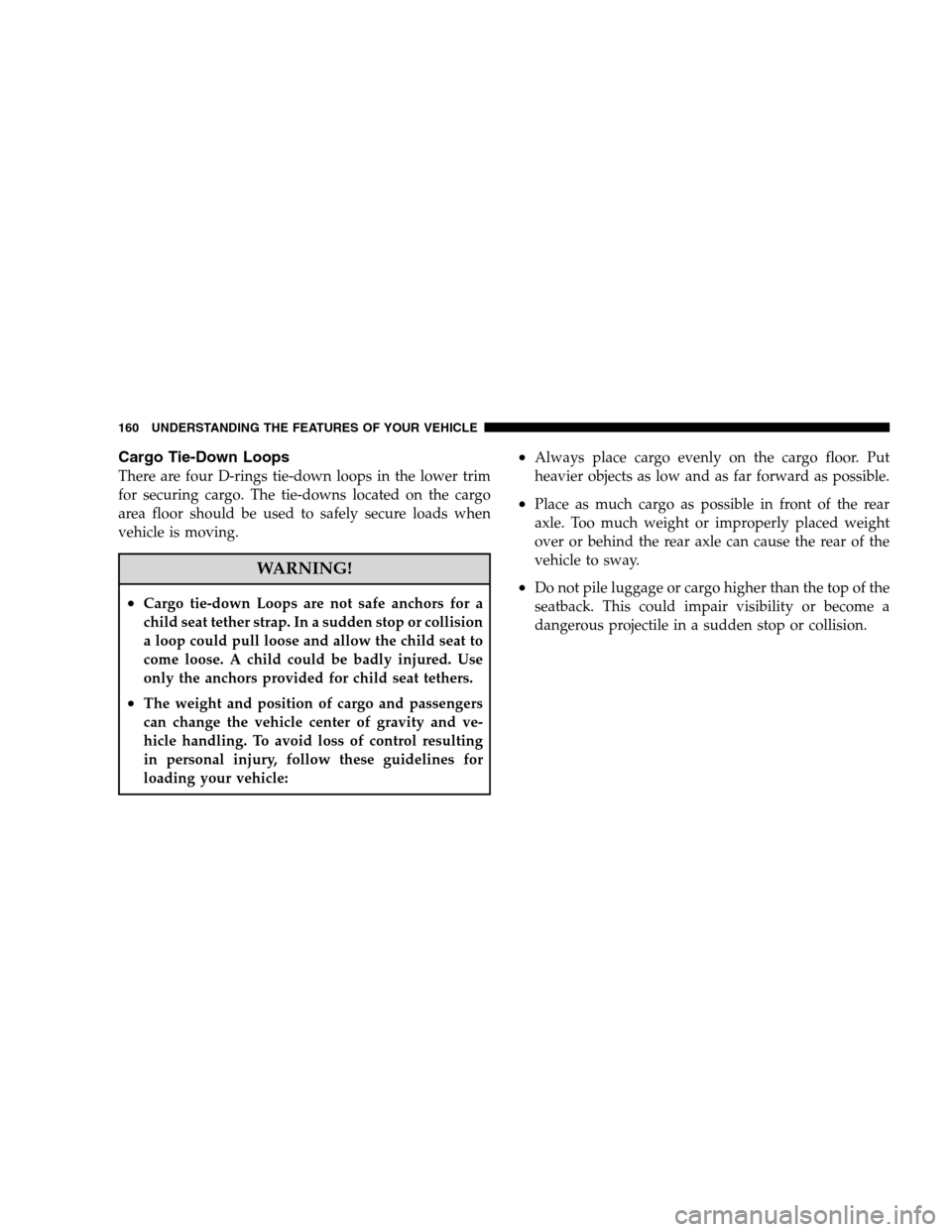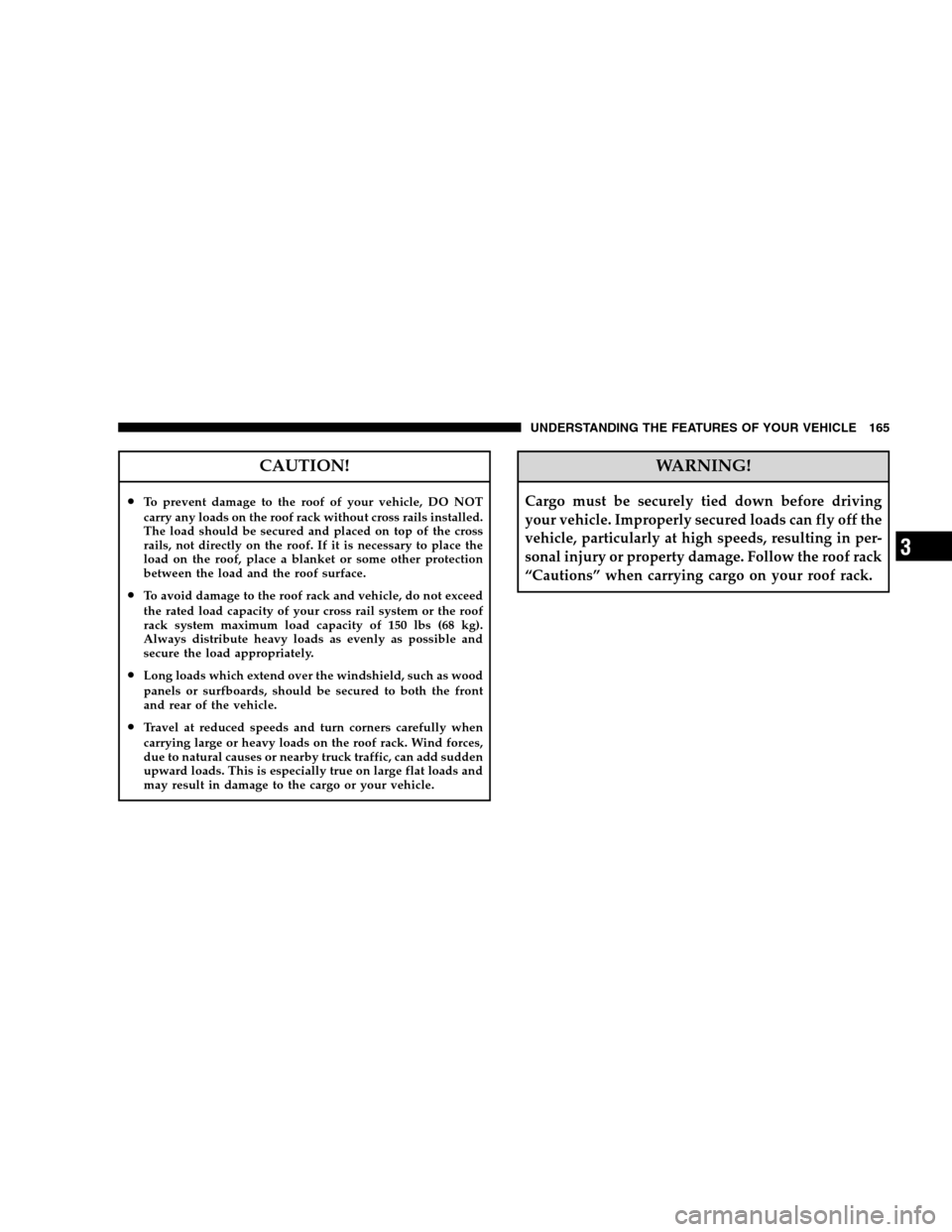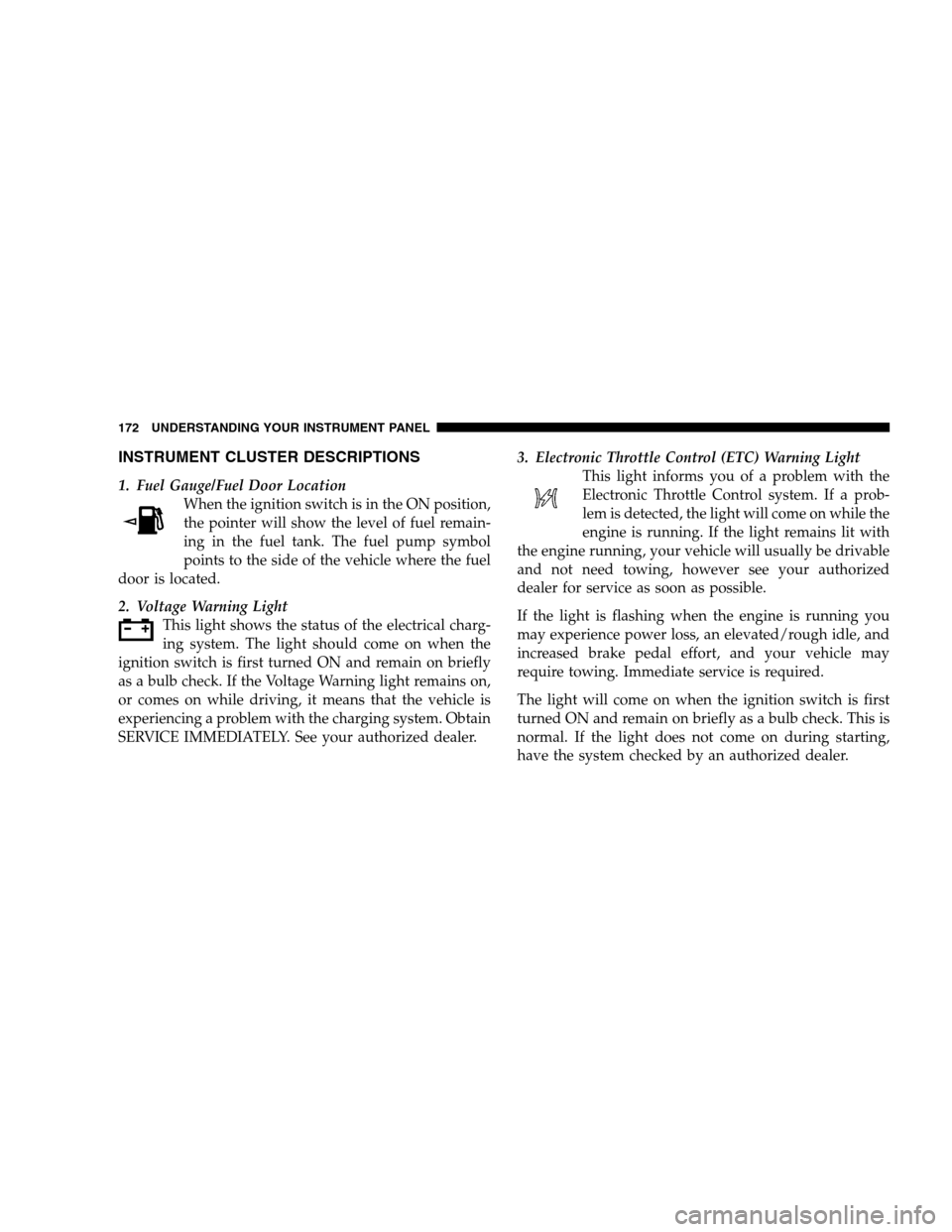Page 157 of 438
CONSOLE FEATURES
WARNING!
Do not operate this vehicle with the console compart-
ment lid in the open position. Cell phones, music
players, and other hand-held electronic devices
should be stowed while driving. Use of these devices
while driving can cause an accident due to distrac-
tion, resulting in death or injury.
The floor console’s sliding armrest moves forward 3 in
(76.2 mm) to accommodate shorter drivers. The armrest
lid also includes a unique flip pocket for storing a phone
or an MP3 player. The bin inside the console can hold up
to 10 CD jewel cases or other items securely out of sight.NOTE:The flip pocket and console lid features are
intended to be used in the upright or open position only
while the vehicle is parked. While driving, all hand-held
devices should be properly stowed, and the flip pocket
and the console lid should be closed.
Floor Console
UNDERSTANDING THE FEATURES OF YOUR VEHICLE 155
3
Page 160 of 438
Retractable Cargo Area Cover — If Equipped
To cover the cargo area:
1. Grasp the center portion of the cover flap. Pull it over
the cargo area.
2. Insert the pins on the ends of the cover into the slots in
the pillar trim cover.3. The liftgate may be opened or closed with the cargo
cover in place.
Cargo Cover Removal
WARNING!
In an accident a cargo cover loose in the vehicle could
cause injury. It could fly around in a sudden stop and
strike someone in the vehicle. Do not store the cargo
cover on the cargo floor or in the passenger compart-
ment. Remove the cover from the vehicle when taken
from its mounting. Do not store in the vehicle.
1. Detach the cargo area cover and allow it to retract.
2. Grasp cargo area cover assembly and push against the
spring tension to the left.
Cargo Cover Extended
158 UNDERSTANDING THE FEATURES OF YOUR VEHICLE
Page 162 of 438

Cargo Tie-Down Loops
There are four D-rings tie-down loops in the lower trim
for securing cargo. The tie-downs located on the cargo
area floor should be used to safely secure loads when
vehicle is moving.
WARNING!
•Cargo tie-down Loops are not safe anchors for a
child seat tether strap. In a sudden stop or collision
a loop could pull loose and allow the child seat to
come loose. A child could be badly injured. Use
only the anchors provided for child seat tethers.
•The weight and position of cargo and passengers
can change the vehicle center of gravity and ve-
hicle handling. To avoid loss of control resulting
in personal injury, follow these guidelines for
loading your vehicle:
•Always place cargo evenly on the cargo floor. Put
heavier objects as low and as far forward as possible.
•Place as much cargo as possible in front of the rear
axle. Too much weight or improperly placed weight
over or behind the rear axle can cause the rear of the
vehicle to sway.
•Do not pile luggage or cargo higher than the top of the
seatback. This could impair visibility or become a
dangerous projectile in a sudden stop or collision.
160 UNDERSTANDING THE FEATURES OF YOUR VEHICLE
Page 163 of 438
WARNING!
To help protect against personal injury, passengers
should not be seated in the rear cargo area. The rear
cargo space is intended for load carrying purposes
only, not for passengers, who should sit in seats and
use seat belts.
Fold Down Speakers — If Equipped
When the liftgate is open, the speakers can swing down
from the trim panel to face rearward, for tailgating and
other activities.
NOTE:Do not close the liftgate with the fold down
speakers opened. The speakers could be damaged if they
come into contact with luggage stored in the cargo area.
Fold Down Speakers
UNDERSTANDING THE FEATURES OF YOUR VEHICLE 161
3
Page 167 of 438

CAUTION!
•To prevent damage to the roof of your vehicle, DO NOT
carry any loads on the roof rack without cross rails installed.
The load should be secured and placed on top of the cross
rails, not directly on the roof. If it is necessary to place the
load on the roof, place a blanket or some other protection
between the load and the roof surface.
•To avoid damage to the roof rack and vehicle, do not exceed
the rated load capacity of your cross rail system or the roof
rack system maximum load capacity of 150 lbs (68 kg).
Always distribute heavy loads as evenly as possible and
secure the load appropriately.
•Long loads which extend over the windshield, such as wood
panels or surfboards, should be secured to both the front
and rear of the vehicle.
•Travel at reduced speeds and turn corners carefully when
carrying large or heavy loads on the roof rack. Wind forces,
due to natural causes or nearby truck traffic, can add sudden
upward loads. This is especially true on large flat loads and
may result in damage to the cargo or your vehicle.
WARNING!
Cargo must be securely tied down before driving
your vehicle. Improperly secured loads can fly off the
vehicle, particularly at high speeds, resulting in per-
sonal injury or property damage. Follow the roof rack
“Cautions” when carrying cargo on your roof rack.
UNDERSTANDING THE FEATURES OF YOUR VEHICLE 165
3
Page 172 of 438
INSTRUMENT PANEL FEATURES
1 — Air Outlet 5 — Glove Box 9 — Hazard Warning Flasher
2 — Demisters 6 — Storage Bin 10 — ESP OFF Switch — If Equipped
3 — Instrument Cluster 7 — Climate Controls
4 — Radio 8 — Heated Seat Switches — If Equipped 170 UNDERSTANDING YOUR INSTRUMENT PANEL
Page 174 of 438

INSTRUMENT CLUSTER DESCRIPTIONS
1. Fuel Gauge/Fuel Door Location
When the ignition switch is in the ON position,
the pointer will show the level of fuel remain-
ing in the fuel tank. The fuel pump symbol
points to the side of the vehicle where the fuel
door is located.
2. Voltage Warning Light
This light shows the status of the electrical charg-
ing system. The light should come on when the
ignition switch is first turned ON and remain on briefly
as a bulb check. If the Voltage Warning light remains on,
or comes on while driving, it means that the vehicle is
experiencing a problem with the charging system. Obtain
SERVICE IMMEDIATELY. See your authorized dealer.3. Electronic Throttle Control (ETC) Warning Light
This light informs you of a problem with the
Electronic Throttle Control system. If a prob-
lem is detected, the light will come on while the
engine is running. If the light remains lit with
the engine running, your vehicle will usually be drivable
and not need towing, however see your authorized
dealer for service as soon as possible.
If the light is flashing when the engine is running you
may experience power loss, an elevated/rough idle, and
increased brake pedal effort, and your vehicle may
require towing. Immediate service is required.
The light will come on when the ignition switch is first
turned ON and remain on briefly as a bulb check. This is
normal. If the light does not come on during starting,
have the system checked by an authorized dealer.
172 UNDERSTANDING YOUR INSTRUMENT PANEL
Page 175 of 438

4. Oil Pressure Warning Light
Shows low engine oil pressure. The light will come
on and remain on when the ignition switch is
turned from the OFF to the ON position, and the light
will turn off after the engine is started. If the light does
not come on during starting, have the system checked by
an authorized dealer.
If the light comes on and remains on while driving, stop
the vehicle and shut OFF the engine. DO NOT OPERATE
THE VEHICLE UNTIL THE CAUSE IS CORRECTED.
The light does not show the quantity of oil in the engine.
This can be determined using the procedure shown in
Section 7.
5. Low Fuel Warning Light
When the fuel level drops to two gallons, the fuel
symbol will light and a single chime will sound.6. Speedometer
Indicates vehicle speed.
7. Airbag Warning Light
The light comes on and remains on for six to
eight seconds as a bulb check when the ignition
switch is first turned ON. If the light does not
come on during starting, stays on, or comes on
while driving, have the system checked by an authorized
dealer.
8. Turn Signal Indicator Light
The arrows will flash in unison with the exterior
turn signal, when using the turn signal lever.
9. High Beam Indicator Light
This light shows that the headlights are on high
beam. Push the turn signal lever away from the
steering wheel to switch the headlights from high or low
beam.
UNDERSTANDING YOUR INSTRUMENT PANEL 173
4